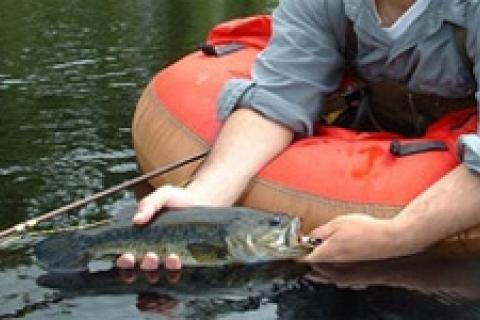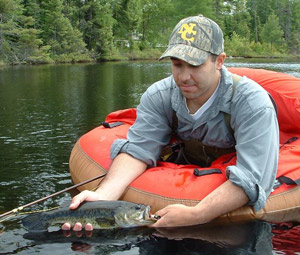
As you probably already know, you can fly fish for almost any species of fish that swim through-out the lower 48 states such as pike, musky, carp, and of course trout. Of the many different species that inhabit these states, one of the most exciting to pursue with a fly rod would have to be the largemouth bass (Micropterus salmoides).
 |
| If you are going to be fishing your poppers out of a float tube a fly rod that is 9 feet or better is a must. |
Maybe it is because of their hardy nature or aggressive attitudes, but bass fishing with a fly rod is becoming one of America's most popular sport fishing opportunities. Bass are a natural fly-rod fish because they spend a lot of time feeding on or near the surface of the water. Largemouth bass in general are a largely territorial, aggressive species; allowing nothing especially noisy, boisterous poppers enter their domain without a strike or two. Casting light weight surface poppers and watching fish voraciously explode these surface targets from below is enough to get the fishing bug going in anybody.
Gear
Generally the most commonly used fly rods for catching largemouth bass are 8-or 9-weight fly rods. These two weights are perfect for casting light weight poppers into cover and getting the attention of any fish below. As far as the fly line goes a weight-forward tapered floating line covers all that you will ever need out on the water. A 7 1/2-foot leader tapered down to 8-pound test will work great for ordinary shore fishing opportunities, where 12-pound test is great for popping through heavy lilies or serious structure. If you are going to be fishing your poppers out of a float tube a fly rod that is 9 feet or better is a must.
Having as much leverage as possible will help you cast easier and farther without expending much energy through-out the day of fishing.
Fly selection
Bass poppers come in a wide variety of styles, shapes and colors. Some boast wide body and deep face designs, while others have slim, elongated bodies with flat faces. The paint jobs are some thing that you would almost expect to see on the finest custom cars with overlaid colors intricate details. Long sultry silicone legs and splayed hackle tip tails bring these poppers to life, even when they rest silent on the waters surface. Choosing what types of popper you will be using is more a personal choice them out of environmental necessity. Although some popper shapes do handle rougher water better than others all can be used in most conditions. Sizing the popper to the target is a key when fishing poppers. Fitting into the surrounding you are fishing and imitating the natural food source is a good idea to start, but if you find aggressively feeding fish do not be afraid to size up a bit to really get their attention.
Similarly, if you're fishing rough, choppy water a bigger popper will definitely hold up better in the rough water and produce a loud pop that the fish will hear from a good distance away.
Technique
 |
| Choosing what types of popper you will be using is more a personal choice then out of enviromental necessity. |
Fishing poppers can be very effective technique for covering large amounts of water and catching good numbers of quality fish. There is no real trick to fly-fishing with poppers. Simply wait until the summer water temperature reaches above 60 degrees and start casting. The retrieve of popper fishing is what really makes this type of fly fishing fun. You control each and every move of the fly and have the ability to either coax a fish to bite or send then running for cover. Before you cast take a good, long look at the water you are about to be fishing and try and visualize where that big lunker would be hiding and waiting to surprise unlucky prey.
After you have picked out your spot, cast the fly towards the target and allow the fly to land with a loud pop letting fish know that your popper is on the water. Sometimes just plopping the fly close to your target is enough to elicit strong strikes from some fish, while others will need a little more coaxing.
A good idea is to let your popper sit for a few seconds after you have casted allowing the water to come to rest again and then starting your retrieve. The retrieve is not a regular pattern of strips and pauses that you may think. Alternating between one and two pops with short pauses between usually works, but throwing in a few three- or four-pop runs every now and then never hurts. Basically you want to try and vary up the retrieve as much as possible.
Don't get stuck doing the same pattern of pops and pauses over and over, try a faster pace or longer pause coupled with the differing amounts of pops. Every fishes feeding habits are different so what works for one may not work for others.
When you do happen to finally hook into a fish, lean back and raise your rod tip to eliminate the slack line on the waters surface. If you are out in open water with little or no significant structure, then getting the fish onto the reel should be your first priority. Once on the reel let the long rod do the work for you and keep the pressure on the fish while you simply collect up the free line as the fish gets closer to you. If you're fishing in heavy cover, you might not have enough time to get the fish onto the reel to fight. Simply pinch the line with your forefinger and strip in any excess while you try and free the fish from the debris.
After all is said and done fly fishing with poppers for largemouth bass is an exciting way to spend your afternoon, while at the same time effectively searching the water for quality fish. On your next trip out to your favorite bass lake take a few poppers along, and see what the craze is all about.
- 18846 views

